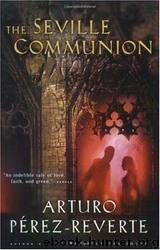The Seville Communion by Arturo Pérez-Reverte

Author:Arturo Pérez-Reverte
Language: eng
Format: mobi, epub
Tags: Mystery & Detective - General, Detective, Mystery & Detective, Fiction - Mystery, General, Literary, Suspense, Catholics, Clergy, Seville (Spain), Thrillers, Fiction, Catholic church buildings
ISBN: 9780156029810
Publisher: Houghton Mifflin Harcourt
Published: 2004-06-15T07:00:00+00:00
1886
Year of construction, England
341
Tons of displacement
47
Length
2.2
Draft
1,800
H.R Moving power
22
Knots
Range
1,800 miles at 10 knots
Armaments
2 of 47 (to stern)
1 of 75 (in the centre)
Crew
27 men (3x4 gunners)
Macarena handed him a folder tied with ribbon. "This dates from later on. My grandfather put it in the trunk after Carlota died. It's an epilogue to the story."
Quart opened the folder. It contained several cuttings from newspapers and illustrated magazines, all dealing with the end of the Spanish-American war and the naval defeat of July 3,1898. A front page from La Ilustracion showed an engraving of the destruction of Admiral Cervera's squadron. There was also a page with an account of the battle, a map of the coast of Santiago de Cuba, and pictures of the principal chiefs of staff and officers killed in the battle. Amongst them Quart found the one he was looking for. The engraving was of poor quality, and a note from the illustrator stated that it had been "drawn based on reliable accounts". It showed a good-looking man with sad eyes, his jacket buttoned to the neck. He had short hair, a large moustache and sideburns. He was the only officer dressed in civilian clothes, and it seemed as if the illustrator had tried to emphasise that this man wasn't a proper member of Cervera's squadron. Captain of the Merchant Navy Mr Manuel Xaloc Ortega, commander of the Manigua. Xaloc stared into space, as if indifferent to being listed among the heroes of Cuba. Below, on the same page, was the text:
The Infanta Maria Teresa, having withstood the concentrated fire of the American squadron for almost an hour, ran aground in flames on the coast. Meanwhile, the other Spanish ships set sail from the Port of Santiago, between the forts of El Morro and Socapa, and were immediately greeted by artillery fire from Sampson's battleships and cruisers, whose strength was overwhelming. The Oquendo, its entire port-side ablaze, guns unfixed, bridges and superstructure almost destroyed and with a large number of dead and wounded on board, passed before its flagship, which had run aground. Unable to continue, its commander (Commodore Lazaga) fallen, the Oquendo ran aground one mile to the west so as not to fall into enemy hands.
Pushing their engines to the limit, the Vizcaya and the Cristabal Colon sailed parallel to the coast, pressed against it by a barrage of North American fire. They passed their destroyed companions, whose survivors were trying to swim to shore. Being faster, the Colon moved ahead, while the unfortunate Vizcaya suffered the full force of the enemy fire. Its commander, Commodore Eulate, made futile attempts to ram the battleship Brooklyn, but the Vizcaya was in flames and ran aground under the intense fire of the Iowa and the Oregon. It was then the turn of the Colon (Commodore Diaz Moreu). At one in the afternoon, pursued by four American ships, defenceless, as it had no heavy artillery, it was forced against the coast and was scuttled by its crew. Meanwhile, without hope of surviving, the light units of the squadron, the destroyers Pluton and Furor, left port one after the other.
Download
The Seville Communion by Arturo Pérez-Reverte.epub
This site does not store any files on its server. We only index and link to content provided by other sites. Please contact the content providers to delete copyright contents if any and email us, we'll remove relevant links or contents immediately.
The Hating Game by Sally Thorne(17463)
The Universe of Us by Lang Leav(14358)
Sad Girls by Lang Leav(13344)
The Lover by Duras Marguerite(7111)
Smoke & Mirrors by Michael Faudet(5506)
The Rosie Project by Graeme Simsion(5185)
The Shadow Of The Wind by Carlos Ruiz Zafón(4932)
Big Little Lies by Liane Moriarty(4876)
The Poppy War by R. F. Kuang(4416)
Memories by Lang Leav(4166)
What Alice Forgot by Liane Moriarty(3915)
An Echo of Things to Come by James Islington(3834)
From Sand and Ash by Amy Harmon(3674)
The Poetry of Pablo Neruda by Pablo Neruda(3358)
The Tattooist of Auschwitz by Heather Morris(3246)
Guild Hunters Novels 1-4 by Nalini Singh(2929)
Ficciones by Jorge Luis Borges(2854)
THE ONE YOU CANNOT HAVE by Shenoy Preeti(2822)
The Rosie Effect by Graeme Simsion(2704)
